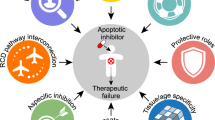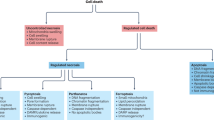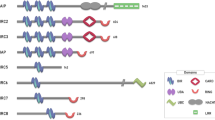Abstract
In a landmark paper published over two decades ago, Kerr et al. proposed the term apoptosis “for a hitherto little recognized mechanism of controlled cell deletion, which appears to play a complementary but opposite role to mitosis in the regulation of animal cell populations”1. In the ensuing years, this natural cell death process was studied at the basic science level, primarily with a view to understanding its roles in cancer and in the development and maintenance of the immune system. More recently, however, evidence has suggested a role for the failure of normal apoptosis control in many of the major diseases of the industrialized world. Though complex, apoptosis appears amenable to therapeutic intervention. The range of modern pharmaceutical strategies available to treat such disregulated gene-directed processes offers promise for advances in the control of cancer, immune system and neurodegenerative disorders, heart disease, and perhaps even the aging process itself.
This is a preview of subscription content, access via your institution
Access options
Subscribe to this journal
Receive 12 print issues and online access
$209.00 per year
only $17.42 per issue
Buy this article
- Purchase on Springer Link
- Instant access to full article PDF
Prices may be subject to local taxes which are calculated during checkout
Similar content being viewed by others
References
Kerr, J.F.R., Wyllie, A.H. and Currie, A.R. 1972. Apoptosis: a basic biological phenomenon with wide-ranging implications in tissue kinetics. Br. J. Cancer 26: 239–257.
Kerr, J.F.R. 1971. Shrinkage necrosis: a distinct mode of cellular death. J. Pathol. 105: 13–20.
Kerr, J.F.R. 1965. A histochemical study of hypertrophy and ischaemic injury of rat liver with special reference to changes in lysosomes. J. Pathol. Bacteriol. 90: 419–455.
Kerr, J.F.R. and Harmon, B.V. 1991. Definition and incidence of apoptosis: an historical perspective, p. 5–29. In: Apoptosis: The Molecular Basis of cell Death. L. D. Tomei and F. O. Cope (Eds.). Cold Spring Harbor Laboratory Press, New York.
Raff, M.C. 1993. Social controls on cell survival and cell death. Nature 356: 397–400.
Martin, S.J., Green, D.R. and Cotter, T.G. 1994. Dicing with death: dissecting the components of the apoptosis machinery. Trends Biochem. Sci. 19: 26–30.
Furuya, Y., Berges, R., Lundmo, P. and Isaacs, J.T. 1994. Cell proliferation, p53 gene expression and intracellular calcium in programmed death: prostate model, p. 231–252. In: Apoptosis II: The Molecular Basis of Apoptosis in Disease. L. D. Tomei and F. O. Cope (Eds. ). Cold Spring Harbor Laboratory Press, New York.
Buttke, T.M. and Sandstrom, P.A. 1994. Oxidative stress as a mediator of apoptosis. Immunology Today 15: 7–10.
Sugarman, B.J., Aggarwal, B.B., Hass, P.E., Figari, I.S. Jr and Shepard, H.M. 1985. Recombinant human tumor necrosis factor-alpha: effects on proliferation of normal and transformed cells in vitro. Science 230: 943–945.
Alderson, M.R., Armitage, R.J., Maraskovsky, E., Tough, T.W., Roux, E., Schooley, K., Ramsdell, F. and Lynch, D.H. 1993. Fas transduces activation signals in normal human T lymphocytes. J. Exp. Med. 178: 2231–2235.
Kane, D.J., Sarafian, T.A., Anton, R., Hahn, H., Gralla, E.B., Valentine, J.S., Ord, T. and Bredesen, D.E. 1993. Bcl-2 inhibition of neural death: decreased generation of reactive oxygen species. Science 262: 1274–1277.
Hockenbery, D.M., Oltvai, Z.N., Yin, X.-M., Milliman, C.L. and Kors-meyer, S.J. 1993. Bcl-2 functions in an antioxidant pathway to prevent apoptosis. Cell 75: 241–251.
Kanter, P., Leister, K.J., Tomei, L.D., Wenner, P.A. and Wenner, C.E. 1984. Epidermal growth factor and tumor promoters prevent DNA fragmentation by different mechanisms. Biochem. Biophys. Res. Commun. 118: 392–399.
Peppelenbosch, M.P., Tertoolen, L.G.J., Hage, W.J. and de Laat, S.W. 1993. Epidermal growth factor-induced actin remodeling is regulated by 5-lipoxy-genase and cyclooxygenase products. Cell 74: 565–575.
Kanter, P.M. and Schwartz, H.S. 1980. Post-repair DNA damage in X-irradiated cultured human tumour cells. Int. J. Radial. Biol. 38: 483–493.
Tomei, L.D., Shapiro, J.P. and Cope, F.O. 1993. Apoptosis in C3H/10T1/2 mouse embryonic cells: evidence for internucleosomal DNA modification in the absence of double-strand cleavage. Proc. Natl. Acad. Sci. USA 90: 853–857.
Leister, K.J., Wenner, C.E. and Tomei, L.D. 1985. Correlation of ouabain-sensitive ion movements with cell cycle activation. Proc. Natl. Acad. Sci. USA 82: 1599–1603.
Morisaki, N., Tomei, L.D., Milo, G.E. and Cornwell, D.G. 1985. Role of prostanoids and lipid peroxides as mediators of the 12-O-tetradecanoylphorbol-13-acetate effect on cell growth. Lipids 20: 602–610.
Witz, G. 1991. Active oxygen species as factors in multistage carcinogenesis. Proc. Soc. Exp. Biol. Med. 198: 675–682.
Tomei, L.D. and Cope, F.O. 1991. p. 1–3. In: Apoptosis: The Molecular Basis of cell Death. L. D. Tomei and F. O. Cope (Eds.). Cold Spring Harbor Laboratory Press, New York.
Tomei, L.D., Cheney, J.C. and Wenner, C.E. 1981. The effect of phorbol esters on the proliferation of C3H-10T1/2 mouse fibroblasts: consideration of both stimulatory and inhibitory effects. J. Cell. Physiol. 107: 385–389.
Hanada, M., Krajewski, S., Tanaka, S., Cazals-Hatem, D., Spengler, B.A., Ross, R.A., Biedler, J.L. and Reed, J.C. 1993. Regulation of Bcl-2 oncopro-tein levels with differentiation of human neuroblastoma cells. Cancer Res. 53: 4978–4986.
Tomei, L.D., Cope, F.O. and Barr, P.J. 1994. Apoptosis: aging and phenorypic fidelity p. 377–396. In: Apoptosis II: The Molecular Basis of Apoptosis in Disease. L. D. Tomei and F. O. Cope (Eds. ). Cold Spring Harbor Laboratory Press, New York.
Williams, G.T. and Smith, C.A. 1993. Molecular regulation of apoptosis: genetic controls on cell death. Cell 74: 777–779.
Tenniswood, M., Taillefer, D., Lakins, J., Guenette, R., Mooibroek, M., Daehlin, L. and Welsh, J. 1994. Control of gene expression during apoptosis in hormone dependent tissues p. 283–311. In: Apoptosis II: The Molecular Basis of Apoptosis in Disease. L. D. Tomei and F. O. Cope (Eds. ). Cold Spring Harbor Laboratory Press, New York.
Carson, D.A. and Ribeire, J.M. 1993. Apoptosis and disease. Lancet 341: 1251–1254.
El-Deiry, W.S., Tokino, T., Velculescu, V.E., Levy, D.B., Parsons, R., Trent, J.M., Lin, D., Mercer, W.E., Kinzler, K.W. and Vogelstein, B. 1993. WAF1, a potential mediator of p53 tumor suppression. Cell 75: 817–825.
Harper, J., Adami, G.R., Wei, N., Keyomarsi, K. and Elledge, S.J. 1993. The p21 Cdk-interacting protein Cip1 is a potent inhibitor of G1 cyclin-dependent kinases. Cell 75: 805–816.
Lane, D.P. 1992. p53, guardian of the genome. Science 358: 15–16.
Tsujimoto, Y., Finger, L.R., Tunis, J., Nowell, P.C. and Croce, C.M. 1984. Cloning of the chromosomic break point of neoplastic B cells with the t(14;18) chromosome translocation. Science 226: 1097–1099.
Hengartner, M.O. and Horvitz, H.R. 1994. C. elegans cell survival gene ced-9 encodes a functional homolog of the mammalian proto-oncogene bcl-2. Cell 76: 665–676.
Reed, J.C., Stein, C., Subasinghe, C., Haldar, S., Croce, C.M., Yum, S. and Cohen, J. 1990. Anti-sense-mediated inhibition of BCL2 proto-oncogene expression and leukemic cell growth: comparisons of phosphodiester and phosphorothioate oligodeoxynucleotides. Cancer Res. 50: 6565–6570.
Karp, J.E. and Broder, S. 1994. New directions in molecular medicine. Cancer Res. 54: 653–665.
Pezzella, F., Turley, H., Kuzu, I., Tungekar, M.F., Dunnill, M.S., Pierce, C.B., Harries, A., Gatter, K.C. and Mason, D.Y. 1993. bcl-2 protein in non-small-cell lung carcinoma. New Eng. J. Med. 329: 690–694.
McArdle, A.H., Reid, E.C., Laplante, M.P. and Freeman, C.R. 1986. Prophylaxis against radiation injury. Arch. Surg. 121: 879–885.
Tomei, L.D. and Cope, F.O. 1991. Nutrient inhibition of radiation-induced apoptosis in intestinal epithelial cells: possible mechanisms of action p. 105–112. In: The Role of Nutrients in Cancer Treatment. Report of the Ninth Ross Conference on Medical Research, Ross Laboratories, Columbus, Ohio.
Adachi, M., Tefferi, A., Greipp, P.R., Kipps, T.J. and Tsujimoto, Y. 1990. Preferential linkage of bcl-2 to immunoglobulin light-chain gene in chronic lymphocytic leukemia. J. Exp. Med. 171: 559–564.
Bursch, W., Lauer, B., Timmerman-Trosiener, I., Barthel, G., Schuppler, J. and Schulte-Hermann, R. 1984. Controlled death (apoptosis) of normal and putative preneoplastic cells in rat liver following withdrawal of tumor promoters. Carcin-ogenesis 5: 453–460.
Miyashita, T. and Reed, J.C. 1993. Bcl-2 oncoprotein blocks chemotherapy-induced apoptosis in a human leukemia cell line. Blood 81: 151–157.
Linnick, M.D., Zobrist, H.R. and Hatfield, M.D. 1993. Evidence supporting a role for programmed cell death in focal cerebral ischemia in rats. Stroke 24: 2002–2009.
Mattson, M.P., Cheng, B., Davis, D., Bryant, K., Leiberburg, I. and Rydel, R.E. 1992. Beta-amyloid peptides destabilize calcium homeostasis and render human cortical neurons vulnerable to excitotoxicity. J. Neuroscience 12: 376–389.
Schehr, R.S. 1994. Therapeutic approaches to Alzheimer's disease. Bio/Technology 12: 140–144.
Olson, L. 1993. NGF and the treatment of Alzheimer's disease. Exp. Neur. 124: 5–15.
Forloni, G., Angeretti, N., Chiesa, R., Monzani, E., Salmona, M., Bugiani, O. and Tagliavini, F. 1993. Neurotoxicity of a prion protein fragment. Nature 362: 543–546.
Meyn, M.S. 1994. Ataxia-telangiectasia, cell cycle checkpoints and programmed cell death in the cellular response to DNA damage. Cancer Res., submitted for publication.
Tomei, L.D., Umansky, S.R., Bathurst, I.C. and Barr, P.J. 1993. Therapeutic intervention and apoptosis. p. 16–17. In: Apoptosis in AIDS and Cancer, Montagnier, L. and Tomei, L. D. (Eds.).
Gianni, L., Corden, B.J. and Myers, C.E. 1983. The biochemical basis of anthracyclin toxicity and antitumor activity. Rev. Biochem. Toxicol. 5: 1–82.
Ameison, J.C. and Capron, A. 1991. Cell dysfunction and depletion in AIDS: the programmed cell death hypothesis. Immunol. Today 12: 102–105.
Gougeon, M.-L. and Montagnier, L. 1993. Apoptosis in AIDS. Science 260: 1269–1270.
Gougeon, M.-L. and Montagnier, L. 1994. Apoptosis in peripheral T lymphocytes during HIV infection: influence of superantigens and correlation with AIDS pathogenesis. p. 5–18. In: Apoptosis II: The Molecular Basis of Apoptosis in Disease. L. D. Tomei and F. O. Cope (Eds. ). Cold Spring Harbor Laboratory Press, New York.
Meyaard, L., Otto, S.A., Jonker, R.R., Mijnster, M.J., Keet, R. and Miedema, F. 1992. Programmed death of T Cells in HIV-1 infection. Science 257: 217–219.
Krowka, J.F., Cuevas, B., Ascher, M.S. and Sheppard, H.W. 1994. Peripheral blood lymphocytes of HIV-infected individuals exhibit elevated levels of the Fas antigen and rapid induction of apoptosis, submitted for publication.
Garchon, H.J. 1992. Non-MHC-linked genes in autoimmune diseases. Curr. Opin. Immunol. 4: 716–722.
Cheng, J., Zhou, T., Liu, C., Shapiro, J.P., Brauer, M.J., Kiefer, M.C., Barr, P.J. and Mountz, J.D. 1994. A soluble form of the Fas molecule protects cells from Fas-mediated apoptosis. Science 263: 1759–1762.
Mountz, J.D. and Gause, W.C. 1993. Murine models of autoimmune disease and Sjogren's syndrome. Curr. Opinion Rheumatol. 5: 557–569.
Zychlinski, A., Prevost, M.C. and Sansonetti, P.J. 1992. Shigella flexneri induces apoptosis in infected macrophages. Nature 358: 167–169.
Lee, F.D. 1993. Importance of apoptosis in the histopathology of drug related lesions in the large intestine. J. Clin. Pathology 46: 118–122.
Chlebowski, R.T., Beall, G., Grosvenor, M., Lillington, L., Weintraub, N., Ambler, C., Richards, E.W., Abbruzzese, B.C., McCamish, M.A. and Cope, F.O. 1993. Long-term effects of early nutritional support with new enterotropic peptide-based formula vs. standard enteral formula in HIV-infected patients: randomized prospective trial. Nutrition 9: 507–512.
Veis, D.J., Sorenson, C.M., Shutter, J.R. and Korsmeyer, S.J. 1993. Bcl-2-deficient mice demonstrate fulminant lymphoid apoptosis, polycystic kidneys, and hypopigmented hair. Cell 75: 229–240.
Koury, M.J. and Bondurant, M.C. 1990. Erythropoietin retards DNA breakdown and prevents programmed death in erythroid progenitor Cella. Science 248: 378–381.
Golstein, P., Ojcius, D.M. and Young, J.D. 1992. Cell death mechanisms and the immune system. Immunol. Rev. 121: 29–65.
Cohen, J.J., Duke, R.C., Fadok, V.A. and Sellins, K. 1992. Apoptosis and programmed cell death in immunity. Ann. Rev. Immunol. 10: 267–293.
Banda, N.K., Bernier, J., Kurahara, D.K., Kurrie, R., Haigwood, N., Sekaly, R.P. and Finkel, T.H. 1992. Cross-linking by HIV gp120 primes T cells for activation-induced apoptosis. J. Exp. Med. 176: 1099–1106.
Cohen, P.L. and Eisenberg, R.A. 1992. The Ipr and gld genes in systemic autoimmunity: life and death in the Fas lane. Immunol. Today 13: 427–428.
White, E. and Gooding, L.R. 1994. Regulation of apoptosis by human adenoviruses. p. 111–142. In: Apoptosis II: The Molecular Basis of Apoptosis in Disease. L. D. Tomei and F. O. Cope (Eds. ). Cold Spring Harbor Laboratory Press, New York.
Heintz, N. 1993. Cell death and the cell cycle: a relationship between transformation and neurodegeneration? Trends Biochem. Sci. 18: 157–159.
Hickman, J.A. 1992. Apoptosis induced by anticancer drugs. Cancer Metastasis Rev. 11: 121–139.
Medawar, P.B. 1946. Old age and natural death. Modern Quarterly 2: 30–49. Reprinted in The Uniqueness of the Individual (ed. P. B. Medawar), pp. 1–27. Methuen and Co., London, 1957.
Medawar, P.B. 1952. An unsolved problem in biology. Lewis, London. Reprinted in The Uniqueness of the Individual (ed. P. B. Medawar), pp. 28–54. Methuen and Co., London, 1957.
Rose, M.R. 1991. Evolutionary Biology of Aging. Oxford University Press, New York, New York.
Franceschi, C., Monti, D., Rosario Scarfi, M., Zeni, P., Temperani, P., Emilia, G., Sansoni, P., Lioi, M. B., Troiano, L., Agnesini, C., Salvioli, S. and Cossarizza, A. 1992. Genomic instability and aging: studies in centenarians (successful aging) and in patients with Down's syndrome (accelerated aging). Ann. New York Acad. Sci. 663: 4–16.
Monti, D., Troiano, L., Grassilli, E., Agnesini, C., Tropea, F., Barbieri, D., Capri, M., Cristafalo, E.A., Salvioli, S., Ronhetti, I., Bellomo, G., Cossarizza, A. and Franceschi, C. 1992. Cell proliferation and cell death in immuno-senescence. Ann. New York Acad. Sci. 663: 250–261.
Michie, C.A., McLean, A., Alcock, C. and Beverley, P. C.L. Lifespan of human lymphocyte subsets defined by CD45 isoforms. Nature 360: 264–265.
Hayflick, L. 1965. The limited in vitro lifetime of human diploid cell strains. Exp. Cell Res. 25: 585–621.
Itoh, N., Yonehara, S., Ishii, A., Yonehara, M., Mizushima, S.-I., Sameshimi, M., Hase, A., Seto, Y. and Nagata, S. 1991. The polypeptide encoded by the cDNA for human cell surface antigen Fas can mediate apoptosis. Cell 66: 233–243.
Oehm, A., Behrmann, I., Falk, W., Pawlita, M., Maier, G., Klas, C., Li-Weber, M., Richards, S., Dhein, J., Trauth, B.C., Ponsting, H. and Krammer, P. 1992. Purification and molecular cloning of the APO-1 cell surface antigen, a member of the tumor necrosis factor/nerve growth factor receptor superfamily. J. Biol. Chem. 267: 10709–10715.
Vincent, J.L., Bakker, J., Marecaux, G., Schandene, L., Kahn, R.J. and Dupont, E. 1992. Administration of anti-TNF antibody improves left ventricular function in septic shock patients. Results of a pilot study. Chest 101: 810–815.
Lindsay, R.M., Altar, C.A., Cedarbaum, J.M., Hyman, C. and Wiegand, S.J. 1993. The therapeutic potential of neurotrophic factors in the treatment of Parkinson's disease. Exp. Neur. 124: 103–118.
Ogasawara, J., Watanabe-Fukunaga, R., Adachi, M., Matsuzawa, A., Kasugai, T., Kitamura, Y., Itoh, N., Suda, T. and Nagata, S. 1993. Lethal effect of the anti-Fas antibody in mice. Nature 364: 806–809.
Suda, T., Takahashi, T., Golstein, P. and Nagata, S. 1993. Molecular cloning and expression of the Fas ligand, a novel member of the tumor necrosis factor family. Cell 75: 1169–1178.
Meredith, J.E., Fazeli, B. and Schwartz, M.A. 1993 The extra cellular matrix as a cell survival factor. Mol. Biol. of the Cell 4: 953–961.
Sarin, A., Adams, D.H. and Henkart, P.A. 1993. Protease inhibitors selectively block T cell receptor triggered programmed cell death in a murine T cell hybridoma and activated peripheral T cells. J. Exp. Med. 178: 1693–1700.
Miura, M., Zhu, H., Rotello, R., Hartwieg, E. A. and Yuan, J. 1994. Induction of apoptosis in flbroblasts by IL-lB-converting enzyme, a mammalian homolog of the C. elegans cell death gene ced-3. Cell 75: 653–660.
Piacentini, M., Davies, P.J.A. and Fesus, L. 1994. Tissue transglutaminases in cells undergoing apoptosis. p. 143–163. In: Apoptosis II: The Molecular Basis of Apoptosis in Disease. L. D. Tomei and F. O. Cope (Eds. ). Cold Spring Harbor Laboratory Press, New York.
Tartaglia, L.A. and Goeddel, D.V. 1992. Two TNF receptors. Immunol. Today 13: 151–153.
Rabizadeh, S., Oh, J., Zhong, L.-T., Yang, J., Bitler, C.M., Butcher, L.L. and Bredesen, D.E. 1992. Induction of apoptosis by the low-affinity NGF receptor. Science 261: 345–348.
Farrah, T. and Smith, C.A. 1992. Emerging cytokine family. Nature 358: 26.
Nakamura, Y., Komatsu, N. and Nakauchi, H. 1992. A truncated erythropoietin receptor that fails to prevent programmed cell death of erythroid cells. Science 257: 1138–1141.
Author information
Authors and Affiliations
Rights and permissions
About this article
Cite this article
Barr, P., Tomei, L. Apoptosis and Its Role in Human Disease. Nat Biotechnol 12, 487–493 (1994). https://doi.org/10.1038/nbt0594-487
Issue Date:
DOI: https://doi.org/10.1038/nbt0594-487
This article is cited by
-
Cytoplasmic localization of programmed cell death 4 contributes to its anti-apoptotic function
Molecular and Cellular Biochemistry (2018)
-
Effects of culture media on the susceptibility of cells to apoptotic cell death
In Vitro Cellular & Developmental Biology - Animal (2014)
-
Loss of programmed cell death 4 induces apoptosis by promoting the translation of procaspase-3 mRNA
Cell Death & Differentiation (2012)
-
Expression of the Fas-ligand gene in ejaculated sperm from adolescents with and without varicocele
Journal of Assisted Reproduction and Genetics (2010)
-
Aging alters the apoptotic response to genotoxic stress
Nature Medicine (2002)



